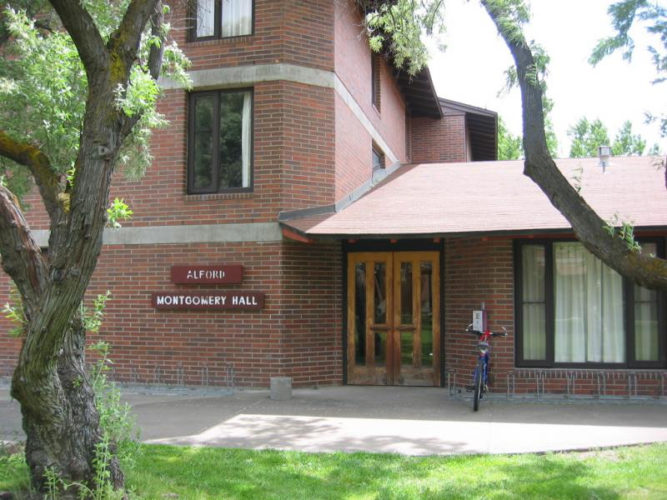
Original Alford Hall
Alford-Montgomery Hall (often called Al-Monty) in the Student Village North area of Central is named for two former Central students who both loved music and lost their lives in the service of their country during World War II.
Clifton “Clif” Alford moved to the Kittitas Valley in 1935. He attended local schools, graduating from Ellensburg High School, and completed his studies at the Central Washington College of Education.
Alford was a gifted and talented musician both in high school and college, playing not only the violin—he was described as a master violinist—but also all brass instruments. The oldest of eight siblings, Alford was active in his local Presbyterian church and played with bands and orchestras at church and special occasions.
After joining the U.S. Army Airs Corps, Alford trained as a pilot and was put in charge of a lumbering B-17 bomber, flying out of Cheveston Airfield, located 60 miles northwest of London.
On August 4, 1944, Alton and his nine-member crew joined a group of more than 100 aircraft making a daytime bombing run on an oil refinery complex on the border between France and Germany, in the vicinity of Alsace, France.
As the aerial convoy grew closer to its target, the Germans began firing their anti-aircraft weapons at the planes. According to reports, Alford’s airplane was hit by an 88 mm anti-aircraft flak shell that exploded either directly into or very close to the forward area of the plane’s bomb bay.
The plane broke apart with the cockpit section crashing into an apple orchard just inside the German border, killing the 24-year-old Alford and his co-pilot as well as the turret gunner, navigator, and bombardier. In the end, all but one member of the crew was killed in the crash.
Alford’s remains were buried at the Lorraine National Cemetery near St. Avold, France.
The other name on the residence hall honors Hamilton “Ham” Montgomery, who graduated from Central in 1939. During his time at the school, Montgomery was, according to the January 5, 1945 Ellensburg Capital newspaper, “one of the best-known students at college here.”
Montgomery was active on the track team as a distance runner and played on Central’s football team. But his passion was music—he had what the paper described as “a marvelous voice”—who also played the coronet and the piano well.
“’Ham had one of the finest baritone voices,’ said Wayne Hertz, head of the music department at Central Washington college,” noted the newspaper. “We had featured him as a soloist and undoubtably he was one of the most popular students here in many years.”
Montgomery, who married a fellow student, Patricia Page, after graduation, had taught high school music for several years before joining the military.
On December 26, 1945, Montgomery, who was sent to the China-India-Burma front and stationed in China, was piloting an Army transport plane in China when his plane apparently ran into difficulties and crashed.
News accounts of the time don’t offer much in terms of detail but the Army listed him as DNB (for Died Non-Battle) and defined such deaths as any that occurred in the line-of-duty outside a combat area. He was 28 years old when he died.
In 1947, Central named two temporary men’s residence facilities after Alford and Montgomery. Following the demolition of those buildings in the late 1960s, Central constructed the Student Village North complex of residence halls and, in the early 1970s named one of the new structures after Alford and Montgomery.
The present Alford-Montgomery Hall is a three-story structure with a brick exterior that, appropriately, houses the Music Living Learning Community for first-year students.






comments powered by Disqus